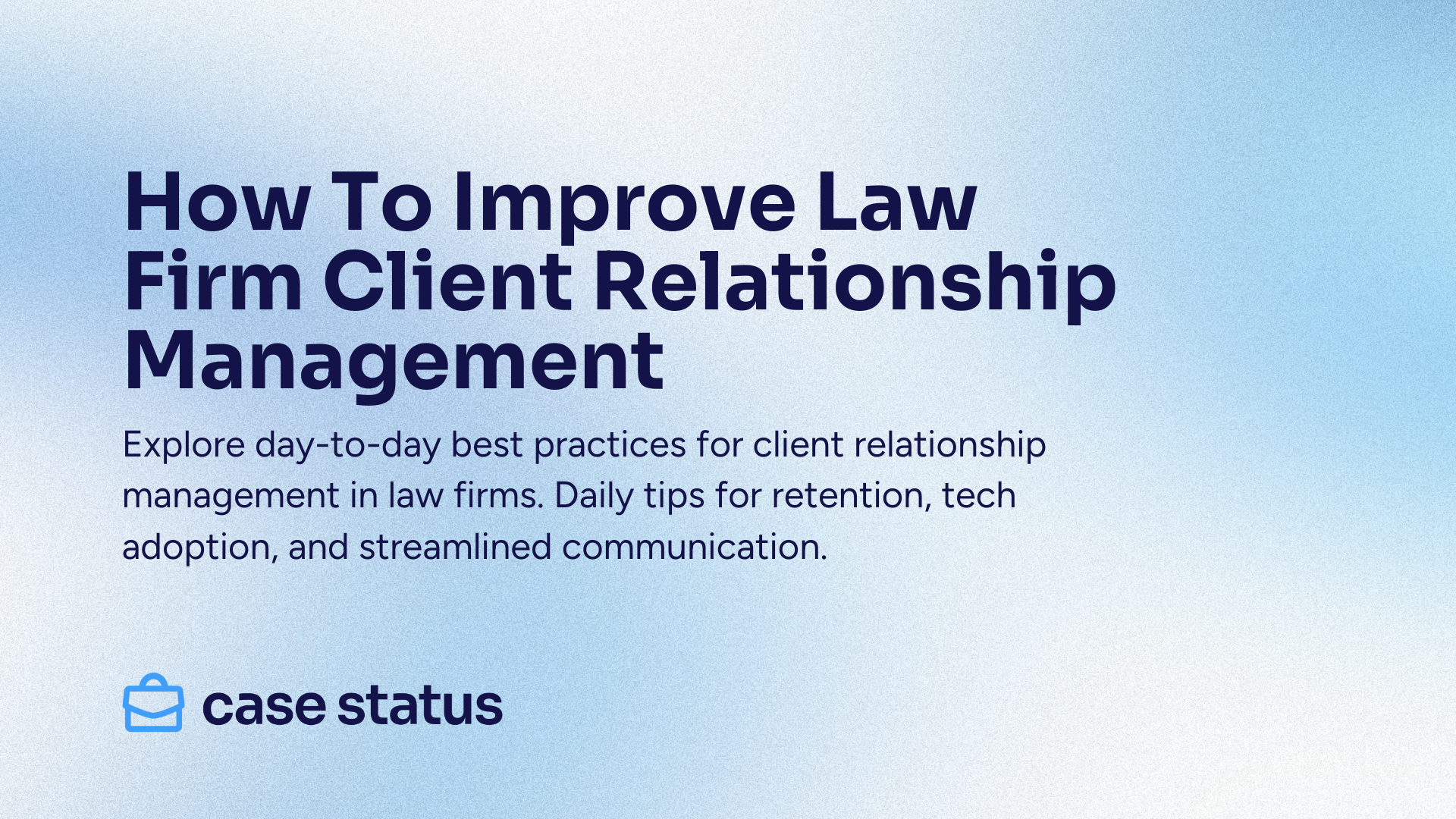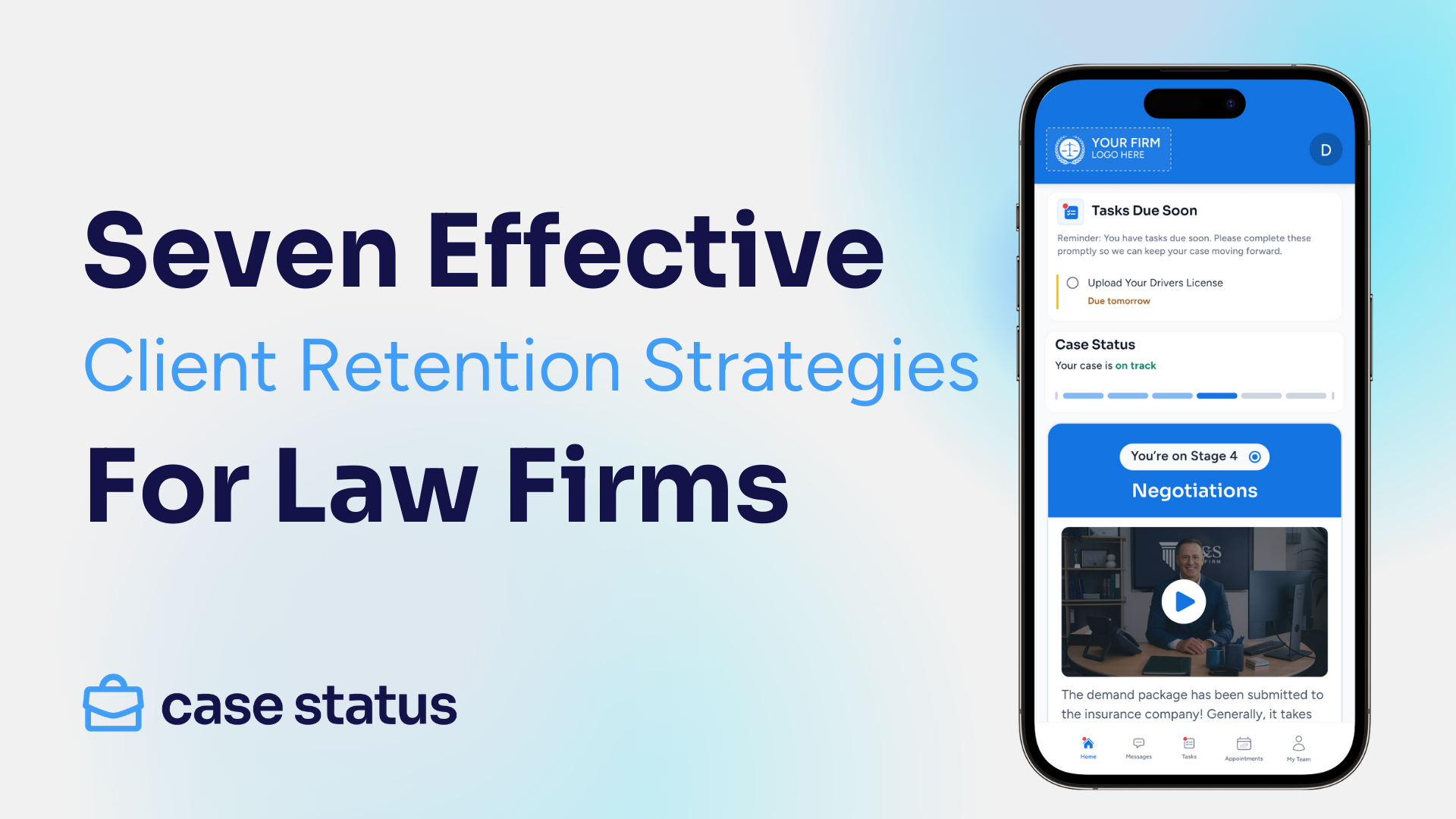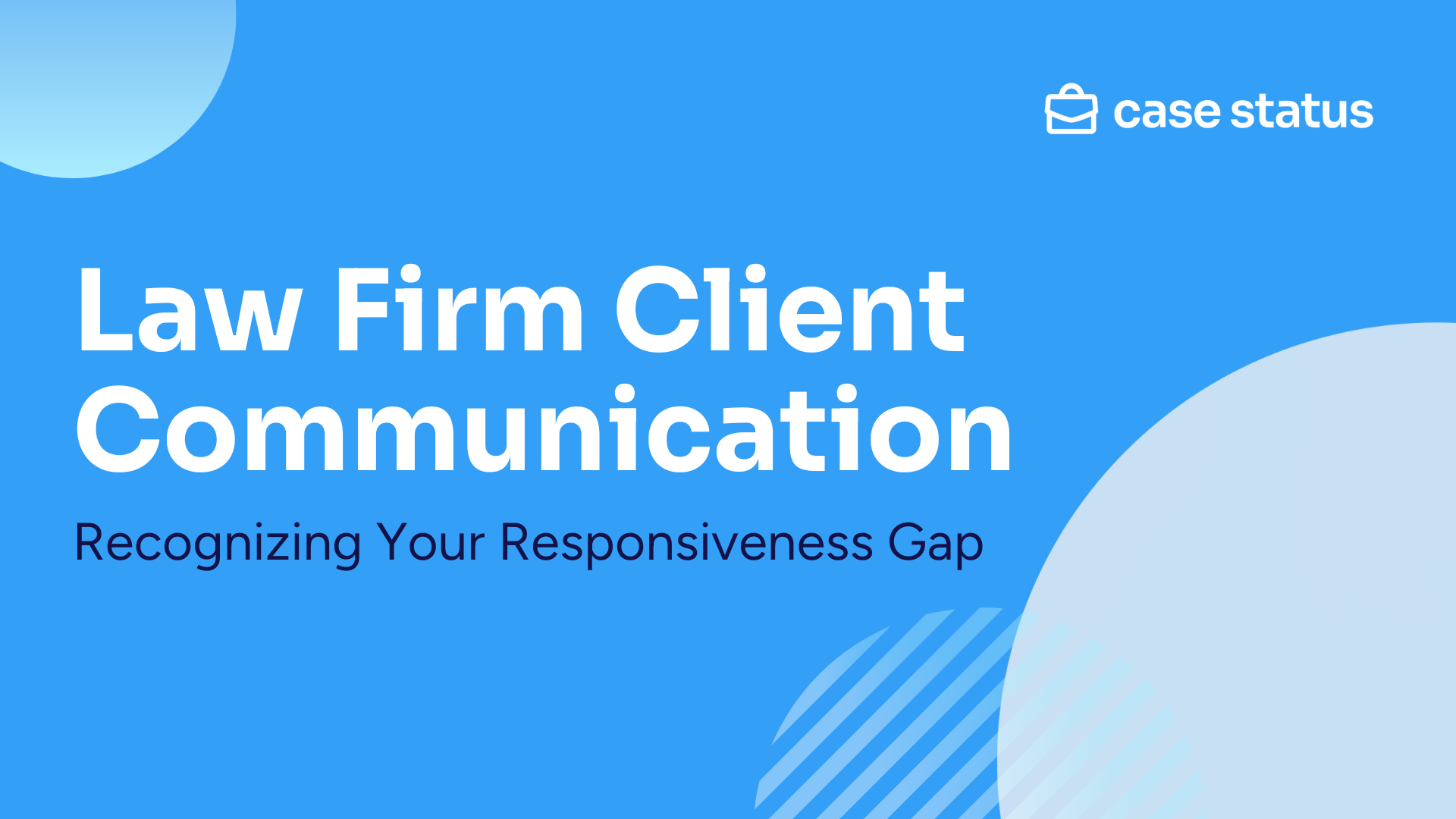
With the importance of word-of-mouth referrals and online reviews, law firm client relationship management is essential for growing revenue. Providing your clients with consistent and clear communication is key to fueling your firm’s growth and building lasting relationships.
In this piece, we’ll look at five strategies for improving client relationship management for law firms, including proactive communication, personal- and community-driven engagement, and utilizing technology to track client satisfaction.
Understanding how to manage a law firm that focuses on client relationships has numerous benefits. You’ll increase client retention, enable your team to work more efficiently, and develop a more streamlined and stress-free workflow for your firm.
Strategy 1: Proactive Communication Instead of Reactive
Lack of communication is among the leading complaints clients have about attorneys. When clients don’t hear from their attorneys, they often assume their case isn’t going well or progressing, or the firm has forgotten about them. The result is that trust in the attorney-client relationship quickly erodes.
The solution is being proactive instead of reactive.
Schedule Regular Updates With Clients
Instead of waiting for clients to ask you for information about their case status, implement systematic case status updates to keep clients informed at regular intervals.
While you don’t want to overwhelm clients with messages, a predictable rhythm of updates - such as weekly or biweekly - reassures clients that their legal matter is being taken care of.
Utilize a Self-Service Portal
Another key to enhancing client communication is to consider when clients are likely to want access to case information. For example, since most people work during the day, they’ll only be able to review case information, documents, and status updates either in the morning or at night.
A self-service mobile platform that can be accessed 24/7 meets clients’ expectations by providing them with the information they need, even outside of your firm’s business hours.
Consider a Real-Time Client Communication Platform
Also, don’t overlook the value of even tiny updates. A brief message to say that a motion was just filed and a response is expected within 30 days can easily be sent via a real-time client communication platform.
This small act requires minimal effort, but builds trust with your clients, which in turn increases the likelihood of them providing referrals and positive reviews.
Establish Client Communication SOPs
Establishing trust requires your firm to have standard operating procedures (SOPs) for communications. By ensuring that clients understand these procedures during the intake process, they’ll be far less likely to feel anxious about their case.
During onboarding, make sure clients know how often they’ll hear from you, what information they’ll receive, and what timelines are realistic.
When you make timelines transparent and communication consistent, clients feel less overwhelmed by their case. If you want to know whether you’re doing enough to keep your clients in the loop, calculate your firm’s communication frequency.
Strategy 2: Master the Small Details That Make Clients Feel Valued
Understanding what makes each client and their case unique goes a long way in how attorney client relationships are formed.
Take Note of and Acknowledge Personal Details
If a client mentions personal details, such as their child’s graduation or what they do for a living, bringing these up later on shows that you see them as a person and not just another case number. While these details may not have anything to do with the case at hand, they help establish your firm as one that can be trusted.
Small gestures like these are unexpected in legal settings, where clients may feel intimidated or may have a perception of the legal profession as being cold and aloof. As a result, when you make a gesture acknowledging your client’s personal life, it has an outsized impact precisely because it is so unexpected.
Understand the Human Side of Each Case
Similarly, understanding what legal clients want includes understanding how their case is more than just a legal issue for them; it often has very real financial and personal effects.
For example, if you’re working with a client to help get their new business established, you can ask how various steps with the process are going, such as buying office space, finding customers, or hiring talent.
Use Tech to Communicate and Connect
You can embrace technology to help foster this personal connection with your clients. For instance, a mobile client portal enables clients to send you messages and review their case documents at whatever hour is convenient to them, showing that their comfort is prioritized.
Likewise, you can use digital calendars to keep track of important milestones, such as birthdays, anniversaries, or business milestones. Even sending an automated message during these important events requires almost no effort, yet goes a long way in showing clients that you value them.
Strategy 3: Foster Client Communities Beyond Individual Cases
Beyond fostering personal one-on-one connections with your clients, you’ll also want to take advantage of the community-building potential of one-to-many communication strategies.
Building a community of clients doesn’t replace the one-on-one communication vital for client relationship management. Instead, providing content that is likely to address the concerns of multiple people frees time to focus more on specific needs, such as case-specific updates.
Social Media
Social media can be an invaluable tool for connecting with clients and is one of the best ways to grow your law firm through client referrals.
You can use social media to share legal insights, industry news, and firm updates - all of which can help keep your firm front and center for current and former clients, while acting as a form of marketing to attract new clients.
Newsletters
Offer newsletters to keep clients up to date on firm news and case results. Newsletters require minimal time and effort, especially since you can reuse content you’ve already recently published, such as blog posts.
Despite the minimal effort, they ensure you maintain a contact point with clients.
Webinars
Webinars are another great way to establish your firm as a trusted resource by focusing on educational topics related to your practice area. Choose topics that are likely to provide genuine value for clients.
For example, if you work in immigration law, you can discuss changes to immigration procedures. Or, if you work in business law, you can hold a webinar on the legal considerations of starting a new business.
Strategy 4: Use Net Promoter Score (NPS) to Prevent Client Fires Before They Happen
Instead of finding out about a dissatisfied client when it’s too late - such as after they’ve left a negative review - your Net Promoter Score (NPS) enables you to predict when clients may be dissatisfied.
By being able to uncover issues with client satisfaction early, you prevent them from becoming major problems that drive away referrals.
What Is NPS, and Who Influences It?
Your NPS is a measure based on the question “On a scale of 0-10, how likely are you to recommend our firm to friends or family?” Clients who answer that question are categorized as such:
- Promoters are clients who rank you highly and are likely to refer your firm to others.
- Passives are clients who are overall satisfied but unlikely to send you referrals.
- Detractors are clients who can hurt your firm with poor reviews and negative word-of-mouth.
Stay on Top of Client Satisfaction
Obviously, you want as many promoters as possible and to turn passives and even detractors into promoters. You can do this by implementing a client feedback tracker that asks clients for their opinion on your firm at key milestones, such as during intake, at important case developments, and after the case conclusion.
By tracking feedback throughout the case, you can identify when concerns are most likely to arise and get out ahead of them.
When your NPS shows that a client is becoming a detractor, that should serve as an alarm that intervention is needed. An immediate phone call by a senior attorney to the unhappy client shows that the matter is being taken seriously and that the client is valued. Proactively engaging with detractors is among the best ways of turning them into promoters.
Similarly, you should engage with passive clients - those who are satisfied with your firm but not enthusiastic about it. You can utilize feedback to find out what would turn these passive clients into promoters, such as more frequent communication or a better explanation of the legal strategy.
Strategy 5: Recover From Communication Breakdowns With Immediate Damage Control
Unfortunately, even with a proactive communication strategy, breakdowns will occur, such as a missed email or unreturned phone call.
While not all communication breakdowns can be prevented, how you respond to them is essential in building a law firm Client Experience (CX) playbook that prioritizes client relationships.
Acknowledge the Mistake
The first thing to do is immediately acknowledge the misstep. Even if the issue hasn’t entirely been fixed, you should reach out to the client directly to acknowledge that there is a problem. Waiting until the issue has already been fixed just leaves the client in the dark and assumes the worst.
Validate the Client’s Concerns
When you reach out to frustrated clients, be sure to validate their concerns. This can be done by reconstructing with the client the steps that occurred that led to the communication breakdown.
For example, they had expected to hear from you but didn’t, or they had tried to contact you but couldn’t get through.
Acknowledging their perspective validates their experience and shows that you value their opinion.
Don’t Assign Blame or Make Excuses
Don’t attempt to deflect blame or make excuses for what happened. Instead, take responsibility and explain how the problem occurred and what you’ll do to prevent it from happening in the future.
For example, you can reassure an unhappy client that you’ve added a weekly reminder to update them on their case. By focusing on solutions, you’ll have taken a key step in how to optimize the client experience.
Use Tech to Improve the Client Experience
Be sure to learn how to improve the client experience with legal technology. For instance, you can use a mobile platform to send regular updates to clients or use AI to draft written apologies to clients that reflect your firm’s tone.
Embracing technology to recover from communication missteps ensures clients feel valued while you’re able to focus on high-value work.
Transform Client Relationships Through Strategic Data-Driven Management
Systematic client relationship management can give your firm a competitive advantage. By tracking communication frequency, monitoring NPS scores, and analyzing client feedback, you can spot problems early and intervene before clients decide to take their business elsewhere.
This proactive approach to client relationships doesn’t just keep your clients happy. It’s a major driver of client retention, referrals, and revenue growth thanks to better word-of-mouth and positive online reviews.
Plus, satisfied clients tend to pay their invoices in full and on time and provide a smoother working experience for your whole team.
No matter your law firm’s size, you can utilize legal technology tools to monitor and improve client relationships effectively and efficiently. With a robust legal technology platform, you can automate crucial steps of the client experience, more easily track feedback, and spot opportunities to transform detractors into enthusiastic promoters of your firm.



